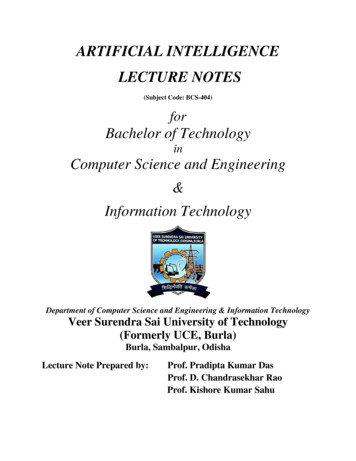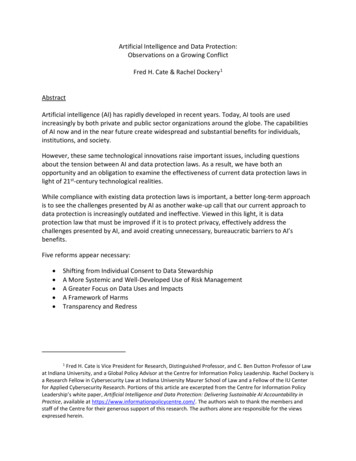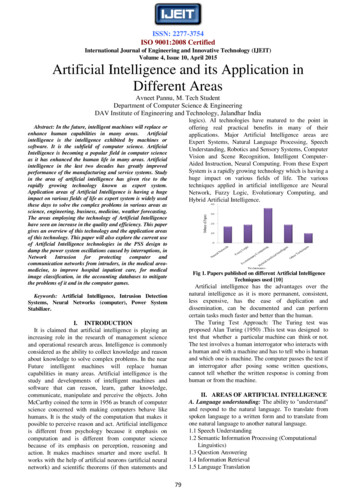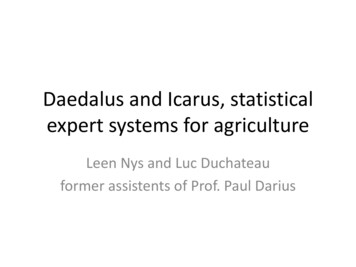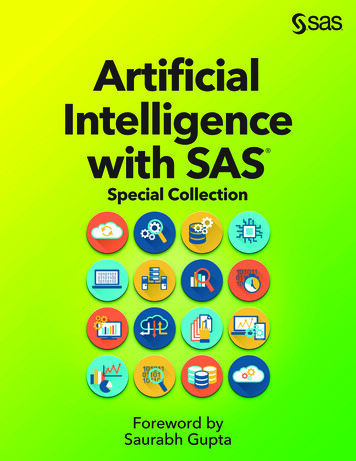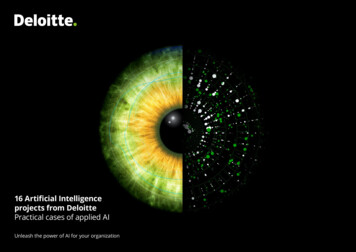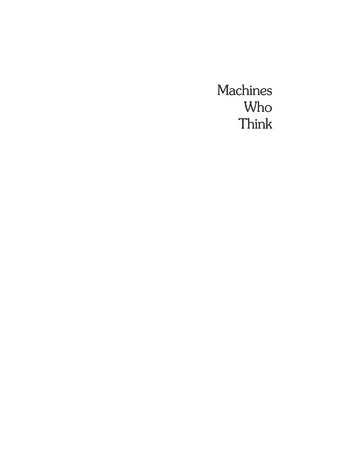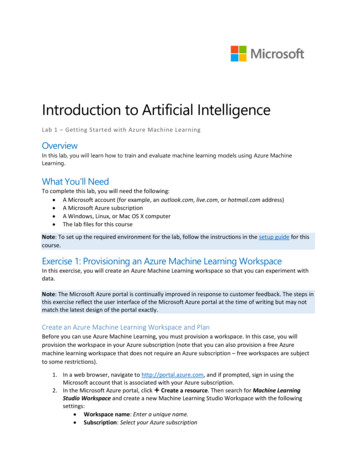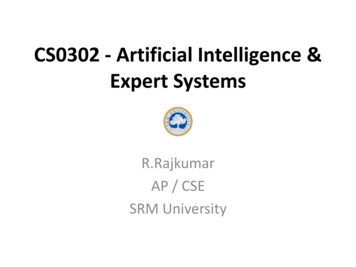
Transcription
CS0302 - Artificial Intelligence &Expert SystemsR.RajkumarAP / CSESRM University
CS0302 - Artificial Intelligence &Expert SystemsRequired Text Books:1.Elaine Rich, "Artificial Intelligence", 2nd Edition,McGraw Hill, 20052. Dan W.Patterson, "Introduction to AI and ES",Pearson Education, 2007
REFERENCE BOOKS 1.Peter Jackson, "Introduction to ExpertSystems", 3rd Edition, Pearson Education,2007 2.Stuart Russel, Peter Norvig "AI - A ModernApproach", 2nd Edition, Pearson Education2007
Objectives 1.To study the concepts of ArtificialIntelligence 2.Methods of solving problems using ArtificialIntelligence 3.Introduce the concepts of Expert Systemsand machine learning
Prerequisite : Remember CS0202 – Principles ofProgramming Languages Common sense
Assessment Details Cycle Test – ISurprise Test – ICycle Test – IIModel ExamAttendance:::::10Marks5 Marks10Marks20 Marks5 Marks
Outcomes Who have successfully completed this coursewill have full understanding of the followingconcepts 1. Various Ideas in AI 2. Various Types of Expert systems& High Grade in Exam
Introduction to AlIntroduction to Intelligence
What is Intelligence? Intelligence:– “the capacity to learn and solve problems” (Webstersdictionary)– in particular, the ability to solve novel problems the ability to act rationally the ability to act like humans Artificial Intelligence– build and understand intelligent entities or agents– 2 main approaches: “engineering” versus “cognitivemodeling”
What is Artificial Intelligence?R.Rajkumar notes What is artificial intelligence?It is the science and engineering of making intelligent machines, especiallyintelligent computer programs. It is related to the similar task of usingcomputers to understand human intelligence, but AI does not have to confineitself to methods that are biologically observable. Yes, but what is intelligence?Intelligence is the computational part of the ability to achieve goals in theworld. Varying kinds and degrees of intelligence occur in people, many animalsand some machines. Isn't there a solid definition of intelligence that doesn't depend on relating itto human intelligence?Not yet. The problem is that we cannot yet characterize in general what kinds ofcomputational procedures we want to call intelligent. We understand some ofthe mechanisms of intelligence and not others.
Exercise
What’s involved in Intelligence? Ability to interact with the real world––––to perceive, understand, and acte.g., speech recognition and understanding and synthesise.g., image understandinge.g., ability to take actions, have an effect Reasoning and Planning– modeling the external world, given input– solving new problems, planning, and making decisions– ability to deal with unexpected problems, uncertainties Learning and Adaptation– we are continuously learning and adapting– our internal models are always being “updated” e.g., a baby learning to categorize and recognize animals
Academic Disciplines relevant to AI PhilosophyLogic, methods of reasoning, mind as physicalsystem, foundations of learning, language,rationality. MathematicsFormal representation and proof, algorithms,computation, (un)decidability, (in)tractability Probability/Statisticsmodeling uncertainty, learning from data Economicsutility, decision theory, rational economic agents Neuroscienceneurons as information processing units. Psychology/Cognitive Sciencehow do people behave, perceive, process cognitiveinformation, represent knowledge. Computerengineeringbuilding fast computers Control theorydesign systems that maximize an objectivefunction over time Linguisticsknowledge representation, grammars
History of AI 1943: early beginnings 1950: Turing 1956: birth of AI 1950s: initial promise 1955-65: “great enthusiasm”– McCulloch & Pitts: Boolean circuit model of brain– Turing's "Computing Machinery and Intelligence“– Dartmouth meeting: "Artificial Intelligence“ name adopted– Early AI programs, including– Samuel's checkers program– Newell & Simon's Logic Theorist– Newell and Simon: GPS, general problem solver– Gelertner: Geometry Theorem Prover– McCarthy: invention of LISP
1966—73: Reality dawns– Realization that many AI problems are intractable– Limitations of existing neural network methods identified Neural network research almost disappears 1969—85: Adding domain knowledge––Development of knowledge-based systemsSuccess of rule-based expert systems, E.g., DENDRAL, MYCIN But were brittle and did not scale well in practice 1986-- Rise of machine learning– Neural networks return to popularity– Major advances in machine learning algorithms and applications 1990-- Role of uncertainty– Bayesian networks as a knowledge representation framework 1995-- AI as Science– Integration of learning, reasoning, knowledge representation– AI methods used in vision, language, data mining, etc
Success Stories Deep Blue defeated the reigning world chess champion Garry Kasparov in1997AI program proved a mathematical conjecture (Robbins conjecture)unsolved for decades During the 1991 Gulf War, US forces deployed an AI logistics planning andscheduling program that involved up to 50,000 vehicles, cargo, and people NASA's on-board autonomous planning program controlled the schedulingof operations for a spacecraft Proverb solves crossword puzzles better than most humans Robot driving: DARPA grand challenge 2003-2007 2006: face recognition software available in consumer cameras 2013: Social network behavior
DARPA Grand Challenge Grand Challenge 2004 Grand Challenge: 2005 Grand Challenge: 2007 Urban Grand Challenge– Cash prizes ( 1 to 2 million) offered to first robots to complete a long coursecompletely unassisted– Stimulates research in vision, robotics, planning, machine learning, reasoning,etc– 150 mile route in Nevada desert– Furthest any robot went was about 7 miles– but hardest terrain was at the beginning of the course– 132 mile race– Narrow tunnels, winding mountain passes, etc– Stanford 1st, CMU 2nd, both finished in about 6 hours– This November in Victorville, California
Stanley RobotStanford Racing TeamNext few slides courtesy of Prof.Sebastian Thrun, Stanford University
Semi-Finalists: 43 Teams
The Grand Challenge Race
What is next?
Consider what might be involved inbuilding a computer like Human . What are the components that might beuseful?– Fast hardware?– Chess-playing at grandmaster level?– Speech interaction? speech synthesis speech recognition speech understanding– Image recognition and understanding ?– Learning?– Planning and decision-making?
Can Computers beat Humans at Chess? Chess Playing is a classic AI problemPoints Ratings– well-defined problem– very complex: difficult for humans to play well 30002800260024002200200018001600140012001966Deep BlueHuman World ChampionDeep ThoughtRatings19711976198119861991Conclusion:– YES: today’s computers can beat even the best human1997
Can Computers Understand speech? Understanding is different to recognition:– “Time flies like an arrow” assume the computer can recognize all the words how many different interpretations are there?
Can Computers Understand speech? Understanding is different to recognition:– “Time flies like an arrow” assume the computer can recognize all the words how many different interpretations are there?––––1. time passes quickly like an arrow?2. command: time the flies the way an arrow times the flies3. command: only time those flies which are like an arrow4. “time-flies” are fond of arrows
Can Computers Understand speech? Understanding is different to recognition:– “Time flies like an arrow” assume the computer can recognize all the words how many different interpretations are there?––––1. time passes quickly like an arrow?2. command: time the flies the way an arrow times the flies3. command: only time those flies which are like an arrow4. “time-flies” are fond of arrows only 1. makes any sense,– but how could a computer figure this out?– clearly humans use a lot of implicit commonsense knowledge incommunication Conclusion: NO, much of what we say is beyond thecapabilities of a computer to understand at present
Can Computers “see”? Recognition v. Understanding (like Speech)– Recognition and Understanding of Objects in a scene look around this room you can effortlessly recognize objects human brain can map 2d visual image to 3d “map” Why is visual recognition a hard problem? Conclusion:– mostly NO: computers can only “see” certain types of objects underlimited circumstances– YES for certain constrained problems (e.g., face recognition)
Can computers plan and make optimal decisions? Intelligence–– What makes planning hard?––– involves solving problems and making decisions and planse.g., you want to take a holiday in Brazil you need to decide on dates, flights you need to get to the airport, etc involves a sequence of decisions, plans, and actionsthe world is not predictable: your flight is canceled or there’s a backup on the 405there are a potentially huge number of details do you consider all flights? all dates?– no: commonsense constrains your solutionsAI systems are only successful in constrained planning problemsConclusion: NO, real-world planning and decision-making is still beyond the capabilitiesof modern computers–exception: very well-defined, constrained problems
Summary of State of AI Systems in Practice Speech synthesis, recognition and understanding–– Computer vision–– adaptive systems are used in many applications: have their limitsPlanning and Reasoning–– works for constrained problems (hand-written zip-codes)understanding real-world, natural scenes is still too hardLearning– very useful for limited vocabulary applicationsunconstrained speech understanding is still too hardonly works for constrained problems: e.g., chessreal-world is too complex for general systemsOverall:––many components of intelligent systems are “doable”there are many interesting research problems remaining
Intelligent Systems in Your Everyday Life Post Office– Banks–– Identifying your age, gender, location, from your Web surfingAutomated fraud detectionDigital Cameras– automatic voice recognitionThe Web–– automatic check readers, signature verification systemsautomated loan application classificationCustomer Service– automatic address recognition and sorting of mailAutomated face detection and focusingComputer Games–Intelligent characters/agents
AI and Web Search
What’s involved in Intelligence? (again) Perceiving, recognizing, understanding the real world Reasoning and planning about the external world Learning and adaptation So what general principles should we use to achievethese goals?
Different Types of Artificial Intelligence1.Modeling exactly how humans actuallythink2.Modeling exactly how humans actually act3.Modeling how ideal agents “should think”4.Modeling how ideal agents “should act”
Acting humanly: Turing test Turing (1950) "Computing machinery and intelligence“ "Can machines think?" "Can machines behave intelligently?“ Operational test for intelligent behavior: the Imitation Game Suggests major components required for AI:- knowledge representation- reasoning,- language/image understanding,- learning* Question: is it important that an intelligent system act like a human?
Thinking humanly Cognitive Science approach– Try to get “inside” our minds– E.g., conduct experiments with people to try to “reverseengineer” how we reason, learning, remember, predict Problems– Humans don’t behave rationally e.g., insurance– The reverse engineering is very hard to do– The brain’s hardware is very different to a computer program
Thinking rationally Represent facts about the world via logic Use logical inference as a basis for reasoning about these facts Can be a very useful approach to AI– E.g., theorem-provers Limitations– Does not account for an agent’s uncertainty about the world E.g., difficult to couple to vision or speech systems– Has no way to represent goals, costs, etc (important aspects of realworld environments)
Acting rationally Decision theory/Economics– Set of future states of the world– Set of possible actions an agent can take– Utility gain to an agent for each action/state pair– An agent acts rationally if it selects the action that maximizes its“utility” Or expected utility if there is uncertainty Emphasis is on autonomous agents that behave rationally(make the best predictions, take the best actions)– on average over time– within computational limitations (“bounded rationality”)
For a machine? Computation (time/memory) Information (data) How do we solve tackle these challengingproblems?
Machine learning Low level intelligence to High level Intelligence
Home work What was the most surprising thing you learnat today?
Summary of Today’s Lecture Artificial Intelligence involves the study of:– automated recognition and understanding of signals– reasoning, planning, and decision-making– learning and adaptation AI has made substantial progress in– recognition and learning– some planning and reasoning problems– but many open research problems AI Applications– improvements in hardware and algorithms AIapplications in industry, finance, medicine, and science.
Computer engineer Vs Computer Scientist
Handwriting recognition
Face detection
Translation
Route planning
Self driven
Physical Assistants
Virtual Assistants
Web searchSpeech recognitionHandwriting recognitionMachine translationInformation extractionDocument summarizationQuestion answeringSpelling correction
Image recognition3D scene reconstructionHuman activity recognitionAutonomous drivingMusic information retrievalAutomatic compositionSocial network analysisProduct recommendationAdvertisement placementSmart-grid energy optimization
Household roboticsRobotic surgeryRobot explorationFraud detectionFault diagnosticsAI for video gamesCharacter animationFinancial tradingProtein foldingMedical diagnosisMedical imaging
CS0302 - Artificial Intelligence & Expert Systems Required Text Books: 1.Elaine Rich, "Artificial Intelligence", 2nd Edition, McGraw Hill, 2005 2. Dan W.Patterson, "Int

